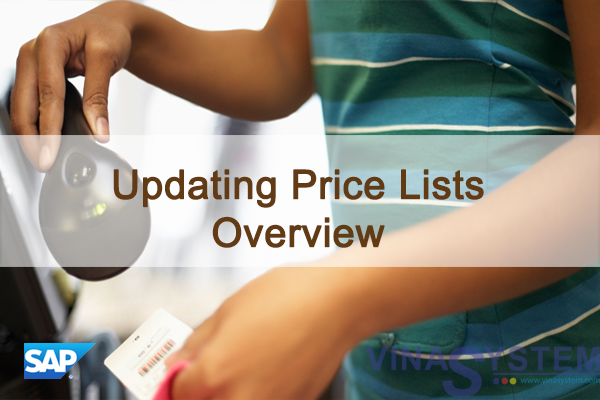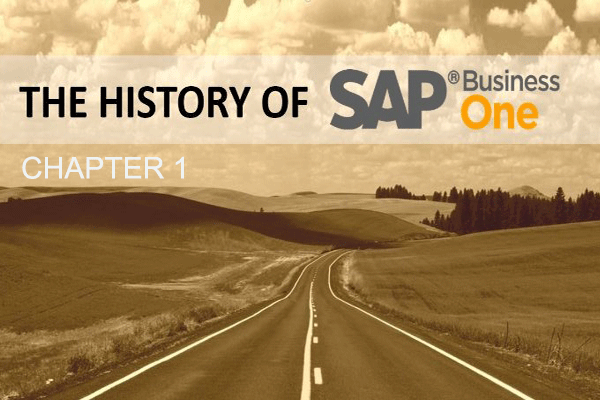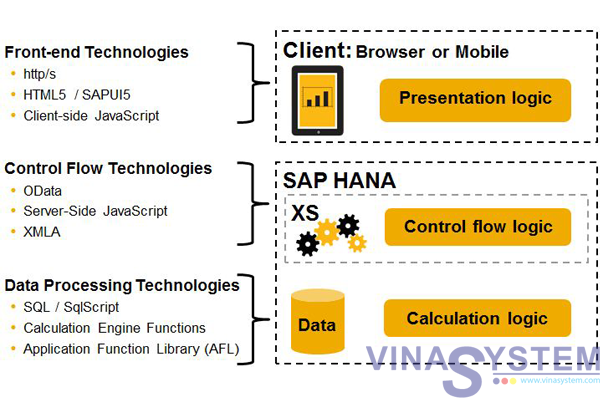
Tài liệu cập nhật bảng giá trong phần mềm SAP Business One
Welcome to the topic on updating pricelists. In this topic, you will be able to describe the available options for updating price lists in SAP Business One.
I/ Business Scenario
The sales manager at OEC Computers has been using factors for setting up relationships between price lists. A number of sales price lists are based on one base price list. When the base price lists changes, the other sales price lists are automatically updated. When he needed to adjust individual prices, he maintained them directly in the price list windows.
He has just learned that he can systematically maintain item prices in multiple price lists using the prices update wizard.
The wizard will allow him more selection parameters and more visibility of the effect of changes before they occur.
II/ Two methods for maintaining pricelists

There are two methods for maintaining prices in your price lists.
The first method is to maintain prices directly in the price list window.
As we saw in the previous lesson, you can use factors for automatic price updates.
You also have the option to make manual changes to individual prices within the price lists. You can open the entire price list to update items or change prices for multiple items within one price list by using the Update by Selection option.
The second method is to use the prices update wizard.
The prices update wizard provides multiple methods to make systematic changes to prices in one or more price lists or to mass convert prices into different currencies.
The wizard guides you through the process and allows you preview changes in simulation mode before making irreversible changes.
In this lesson we will explore the two methods and discuss how they are used.
1/ Example 1:
a) Maintaining Prices in the Price List

The sales manager currently has a number of price lists that are based on a base price list. He uses factors to manage the percentage differences between the base price list and all other price lists.
For example, prices in the seasonal price list are set to always be double the prices on the base price list.
The advantage of this method is that percentage increases are easy to manage in the multiple price lists based on the base price list.
The only issue is when some prices need to vary from the standard percentage. In those cases, he makes changes directly in the price list. He can make changes to one item price or he can use selection criteria to choose multiple item prices to change.
b) Automatic Pricing for a Price List

In the previous course on creating price lists, we saw how you can base a price list on another price list by using a factor.
For example, when the company decided they needed a new price list for schools, the manager created a price list based on the base price list with a factor of 2.
The factor is used as a multiplier. Every price on the Schools price list is 2x the price on the Base Price List.
Anytime the base price list changes, the Schools price list is automatically updated.
This is a useful way to have automatic pricing updates.
c) Manually Update Individual Prices

Although the automatic update feature has been useful, the sales manager has found that sometimes certain products on a price list may need to be changed in order to sell better in the marketplace.
The tablet on the base price list is set at 270 so the automatic pricing from the factor sets the price at 540.
However, the sales manager feels that this product would sell better to schools at a regular price of 500.

Therefore, he sets the price to 500 directly in the school price list.
Once he changes this price, the manual checkbox is set and the price is no longer maintained automatically.
This method works well when there are only a few changes at a time.
d) Set a Different Base Price List / Factor at Item Level

Another option is to set an item to use a different base price list or factor for automatic pricing.
Here again, we see a price list based on a base price list with a factor of 2.
This time the tablet has been set to be based on a different price list. The tablet is based on the discount price list with a factor of 2.5.
The tablet price will not change when the other items change, instead the price of this item will change whenever the discount price list changes.
e) Update Price List by Selection

A third option for maintaining prices inside the Price List window is the Update Price List By Selection.
In the Price Lists window, choose the radio button for Update by Selection.
Then choose the price list you wish to maintain.
Use the selection criteria to choose which prices to maintain. You can choose item prices by vendors, item numbers, item groups and properties.
The selection of item prices will appear and you can make any changes.
All prices changed will be marked as manual and will no longer be automatically updated when a base price list changes.
f) Update Price Wizard

When one or more a price lists need more extensive updates, a better practice is to use the update prices wizard.
The update prices wizard is very flexible and will allow you to change selected items on one or more price lists by 4 methods.
- You can use the Item Prices method to update items prices using a mathematical operation or by setting a value for the price.
- You can use the Base Price List method to change the factor and/or base price list for one or more price lists.
- You can use the Convert to method to convert prices in a price list from one currency to another.
- You can use the UoM Reduce By Percentage method to make a mass adjustment to prices based on a unit of measure by changing the Reduce By Percentage field value.
Let’s look through some examples that will make the wizard’s capabilities clearer.
2/ Example 2:
a) Setting percentage price changes in the wizard

The sales manager wants to adjust all products for a particular manufacturer by 5%.
All products manufactured by Rainbow should be increased by 5% on all sales price lists, except the Web price list.
No unpriced items should be updated. No inactive items should be updated.
We will use the Prices Update wizard to make these changes.
b) Choose Update Method

The first step in the wizard is to choose the update method.
In our first example, the sales manager wants us to increase the item price by 5 percent.
Therefore we choose the Item Prices method to make this adjustment.
The Item Prices method gives us the option to multiply, divide, add, subtract or set a value.
We choose multiply and enter the value 1.05.
c) Item Prices – operations available

In our example, we used the option to multiply the price, however there are 4 other options. Let’s look at how they work.
Let’s assume we have an item currently priced at 10 and let’s see how the other options work if we are entering the value of 2.
If we choose multiply and enter the value 2, 10 is multiplied by 2 and the resulting price is 20.
If we choose divide, 10 is divided by 2 and the resulting price is 5.
If we choose add, the system adds 2 and results in a price of 12.
If we choose subtract, the system subtracts 2 and results in a price of 8.
If we choose the Set Value operation, then it doesn’t matter what the initial value was. The value entered is used as the resulting price.
d) Select Items

The second step is for selection criteria.
In this step, we first select the items that need a pricing change.
We have options to select items based on a range of preferred vendors, a range of item numbers, by item group, by manufacturer, or by item properties.
If choosing items or vendors by range, remember to pick both a beginning and end of a range. For example, if you only want item A1000, you need to choose From A1000 to A1000 or else if you choose from A1000 you will get all items that follow such as A1001 and so on.
This window also allows us to exclude items that are unpriced or inactive.
In our example, the sales manager wants to change prices for the items manufactured by Rainbow, while excluding any unpriced or inactive items.
Then we choose Next to go to the second part of the Selection Criteria step.
e) Select Price Lists to Change

Within the Selection Criteria step, you also need to change the types of prices you wish to change.
First we choose the price list or price lists we want to include.
In our example the sales manager wants to change all the sales price lists except the Web price list. To do this, we chooses the Browse button to open the Price Lists window to select multiple price lists.
Another option on this window allows you to decide whether you are changing prices for the primary currency or for additional currencies. In our example, we only want to change prices in the primary currency.
f) Select Unit Prices to Change

A third option within the price selection window is which units of measure prices should be included in the change.
You can choose to include only the manual unit of measure group, only other unit of measure groups or both types of unit of measure groups. When you choose other or both, the Units of Measure window will open.
Here you can choose to update prices inventory units of measure or specific units. Once you’ve made that choice you can then search for and choose the specific units you wish to update.
g) View Simulation

The third step in the wizard is view a simulation of the price changes.
You can view the simulation by Items or by Price Lists.
If you view by Items, you can choose which items to update.
If you view by Price List, you can choose whether or not to update that price list, but not choose specific items to include or exclude within the price list.
You can expand or collapse the report and move between pages.
If the simulation shows you something you would like to change, you can use the Back button to go back to previous steps to make changes.
The final step is to select the checkbox for the rows you wish to change, and then choose Execute. You will receive a message that warns you that if other users are making changes to the database, you may receive different results than shown in the simulation. In general, it is a best practice to make changes with the pricing wizard during times you know that other users will not be updating prices.
Once you choose Execute, you cannot reverse the changes.
h) View Results

The fourth step of the wizard displays the results of your changes.
You can view information on what has changed with a date and time. If there are errors, you will see them as well.
We saw before that making individual changes in a price list causes the system to set the manual checkbox. The manual checkbox is also set for changes to item prices when using the prices update wizard.
3/ Example 3:
a) Changing base price list and factors

Let’s look at a scenario that uses another option in the Prices Update Wizard.
Currently the discount price list is based on the base price list with a factor of 0.5.
The sales manager wants to change the factor for the accessories item group to 0.75.
In the Prices Update Wizard we choose the option Base Price List. This option allows us the ability to change both the factor of a price list, and if we want, the price list that is used as a base pricelist.
b) Base Price List option

Once you choose the Base Price List option, you have the choice of both the current or a new base price list.
If you choose Current Base Price List, the base price list remains the same and you can choose a new factor. This is what we would do in example 3. We want to keep the base price list but just adjust the factor.
Or you can choose a different price list as a new base. You can pick any existing price list as the base.
Another option is to base a price list on itself. Typically you would do this when you no longer want to have a price list automatically updated. Once you choose Same as Target and a factor of 1, you can maintain that price list directly either in the wizard or directly in the price list window.
4/ Example 4:
a) Converting currency for a price list

Another use of the Prices Update Wizard is to convert a price list’s currency.
In example 4, you have a sales price list that you would like to reuse for some new international customers. Currently the price list has prices in 3 currencies – one main currency and two additional ones. You need to a fourth currency for this price list.
You can choose the Convert to option. This option will convert prices from one currency to another.
b) Convert to option

In our example we wanted to duplicate an existing price list and change the main currency. Once we have the new price list, we can open the Prices Update wizard and choose the ‘Convert to’ Option.
Choose the new currency from the dropdown. The default rate is taken from the rate set in the Exchange Rates and Indexes window. Users can change the rate manually.
In the following windows you can choose to change selected items or an entire price list. In our example, we would choose our new price list.
Then you can choose whether to change the primary currency or one of the additional currencies.
5/ Example 5:
a) Adjust Unit of Measure Pricing

Another the last option in the Prices Update Wizard allows you to adjust unit of measure pricing.
In example 5, the sales manager decides to make additional price reductions for sales of cartons of printer paper.
He would like to offer a 10% reduction for cartons of printer paper in two price lists, the Schools price list and the Small Account price list. Currently cartons only have a 5% discount in those price lists over the price to purchase the number of packs equal to a carton.
To do this we will change the value 5 to the value 10 in the UoM Reduce By % field for selected items of printer paper on the two price lists.
In the Prices Update Wizard, we choose the ‘UoM Reduce By Percentage’ option.
b) Reduce By % Field

The Reduce By % field in Unit of Measure Prices allows us to give a discount for specific units.
In our example, let’s assume the price of a pack of printer paper is 2 on our Schools Price List.
A carton is comprised of 24 packs.
Therefore, the base price of a carton (without any discount) is 48.
The Reduce By % field allows us to give a discount from that price.
Currently the discount is 5%, so the price of a carton is 47.10.
So if we give a discount of 10%, the price of a carton will change to 44.20.
We could make this change manually in a price list, but for multiple items on multiple price lists, it is much easier to make the change in the Prices Update wizard.
c) Changing the UoM Reduce By %

In the Prices Update Wizard: We set the unit of measure reduce by percentage to be equal to 10. This will give a 10% discount for cartons.
Next, in the selection criteria windows, we select the printer paper items and then choose the two affected price lists and the unit of measure.
In the simulation, we will see the current price and suggested price and can choose to execute the change.
III/ Update Prices Wizard vs. Copy UoM Reduce By %

The Update Prices Wizard cannot create a new Unit of Measure Reduce By % entry. The wizard can only change existing entries.
Use the Update Prices Wizard to change existing amounts. Each units of measure must already have an entry with an amount to be updated.
So if there is currently no UoM Reduce By % amount for a specific unit of measure in a pricelist, the wizard will have no effect.
In cases where you want to enter a large number of new UoM Reduce by % amounts for units of measure, use the Copy Reduce By % function.
Enter UoM Reduce By % values for one item in a price list, then you can use those values as a source to copy to other products and/or other pricelists.
IV/ Summary
Here are some key points:
- You can base a price list on another price list and use factors as a multiplier.
- When the base price list is changed, all price lists based on it will change.
- You can make manual changes directly in a price list.
- When you make a manual change to a price on a price list that uses factors, that changed price is no longer updated automatically.
- The Prices Update wizard allows you to make mass changes to multiple price lists at the same time.
- Options in the wizard include changing item prices, setting new base price lists and factors, converting currency for a price list, and adjusting unit of measure prices using the Reduce By Percentage field.
- Prices changed with the Item Prices option in the Prices Update Wizard will be set as Manual and no longer subject to automatic pricing updates.
- The Prices Update wizard includes a simulation step so that you can double-check your changes before they take effect.






